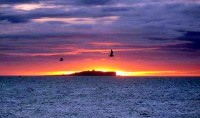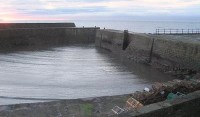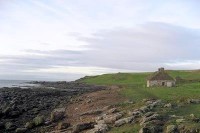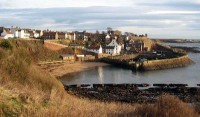The Fife Coastal Path is an 82-mi/132-km trail that runs along the southern and eastern coasts of Fife from North Queensferry (near Edinburgh) to Tayport (near Dundee). It takes approximately six days to walk the path in full.  A small stretch of it, to which I became particularly attached during a yearlong residency in the area, connects the two fishing villages of Anstruther and Crail. This 4-mi/6.3-km section can be walked leisurely in the morning or an afternoon. If you’re in Fife already, your most likely point of departure will be St Andrews, home of the ancient university and golf. From there, Anstruther is an inexpensive, twenty-minute bus ride away.
A small stretch of it, to which I became particularly attached during a yearlong residency in the area, connects the two fishing villages of Anstruther and Crail. This 4-mi/6.3-km section can be walked leisurely in the morning or an afternoon. If you’re in Fife already, your most likely point of departure will be St Andrews, home of the ancient university and golf. From there, Anstruther is an inexpensive, twenty-minute bus ride away.
Anstruther
When you arrive in Anstruther, take some time to wander the narrow, cottage-lined streets. Many houses in the village, such as the seashell covered “Buckie House,” have interesting histories. (I’ve found the residents proud of their piece of Fife and generally eager to relate its local lore, so while I wouldn’t recommend knocking on doors, don’t be too shy with passers-by.) Inevitably, you’ll end up at Anstruther’s main concourse: the harbor. Today, the harbor is filled chiefly with small yachts and other pleasure boats, but several fishermen trapping lobster and crab still operate out of the area. To commemorate the rich fishing traditions, the Scottish Fisheries Museum sits in a prominent position nearby. However, aside from its atmosphere, the harbor’s best treat is the Anstruther Fish Bar, an award-winning fish and chip shop known throughout Scotland. On a nice day, get some haddock (or halibut or trout or sole) and eat at the benches along the harbor, watch the crews busy with their ships, and relax at the heart of this picturesque village.
 As an alternative to Crail, an excellent destination from Anstruther is the Isle of May. Daily trips to this 1-mile long nature reserve last from 4 to 5 hours with 3 hours spent on the island, home to thousands of seabirds, a group of Grey Seals, several disused lighthouses (one built by Robert Louis Stevenson’s grandfather), and one automated lighthouse.
As an alternative to Crail, an excellent destination from Anstruther is the Isle of May. Daily trips to this 1-mile long nature reserve last from 4 to 5 hours with 3 hours spent on the island, home to thousands of seabirds, a group of Grey Seals, several disused lighthouses (one built by Robert Louis Stevenson’s grandfather), and one automated lighthouse.
Along the Path
 From Anstruther’s harbor, head east along the road closest to the sea. A row of houses will block your view intermittently as your pass through the abutting village of Cellardyke. The most remarkable feature of Cellardyke is its own harbor, a secluded 16th century construction lined with traditional white houses. I have found few things more serene than the deep quietude of this empty waterfront strewn with its tired traps and fishing nets still silver with scales. After a pause to explore, keep following the road east and in a few minutes you’ll gain a true footpath near a small, craggy beach. Though little more than a soft wear in the grass marks the trail at times, you’ll be bounded by clear farmland and hills to the northwest and the open sea to the southeast, making it impossible to lose your bearings. Be sure to use the kissing gates and stiles appropriately and to leave all other gates as you find them; much of the area you’ll pass through is the far end of pasture.
From Anstruther’s harbor, head east along the road closest to the sea. A row of houses will block your view intermittently as your pass through the abutting village of Cellardyke. The most remarkable feature of Cellardyke is its own harbor, a secluded 16th century construction lined with traditional white houses. I have found few things more serene than the deep quietude of this empty waterfront strewn with its tired traps and fishing nets still silver with scales. After a pause to explore, keep following the road east and in a few minutes you’ll gain a true footpath near a small, craggy beach. Though little more than a soft wear in the grass marks the trail at times, you’ll be bounded by clear farmland and hills to the northwest and the open sea to the southeast, making it impossible to lose your bearings. Be sure to use the kissing gates and stiles appropriately and to leave all other gates as you find them; much of the area you’ll pass through is the far end of pasture.
 Halfway between Cellardyke and Crail stand the Caiplie Caves, their sandstone weathered by centuries of wind and waves. Don’t be surprised to find campfire remains, or even another traveler, at the entrance. If you look inside, you’ll see ancient crosses carved on the walls by monks journeying to St Andrews. A little further on, you’ll pass the ruins of two small houses before rounding a hill and descending into Crail.
Halfway between Cellardyke and Crail stand the Caiplie Caves, their sandstone weathered by centuries of wind and waves. Don’t be surprised to find campfire remains, or even another traveler, at the entrance. If you look inside, you’ll see ancient crosses carved on the walls by monks journeying to St Andrews. A little further on, you’ll pass the ruins of two small houses before rounding a hill and descending into Crail.
Crail
 Another harbor, perhaps the most like a postcard of the three, is the first you’ll see of Crail as the path winds you off dirt and onto pavement. The harbor was built in the 16th century, but the west pier (another of Robert Louis Stevenson’s grandfather’s constructions) is a later addition. At one point, Crail boasted the largest fish market in Europe and a Dutch church bell. Dutch-influenced architecture lead some scholars to believe the village traded with the continent very early on. Wander the streets and you’ll discover a 13th century church containing a cross-slab preserved from the Dark Ages, several art galleries, and the Crail Pottery. Regular buses run from Crail to St Andrews (or nearly anywhere else in Fife); and of course you could start your walk in Crail and head toward Anstruther, but walking west to east has always seemed more natural to me.
Another harbor, perhaps the most like a postcard of the three, is the first you’ll see of Crail as the path winds you off dirt and onto pavement. The harbor was built in the 16th century, but the west pier (another of Robert Louis Stevenson’s grandfather’s constructions) is a later addition. At one point, Crail boasted the largest fish market in Europe and a Dutch church bell. Dutch-influenced architecture lead some scholars to believe the village traded with the continent very early on. Wander the streets and you’ll discover a 13th century church containing a cross-slab preserved from the Dark Ages, several art galleries, and the Crail Pottery. Regular buses run from Crail to St Andrews (or nearly anywhere else in Fife); and of course you could start your walk in Crail and head toward Anstruther, but walking west to east has always seemed more natural to me.
More on Fife
If you find yourself especially enamored of Fife, its fishing villages, old churches, and charming cottages, pick up (or, more likely, visit your library to acquire) David Hay Fleming’s 1886 Guide to East Neuk Fife. East Neuk is the general area of Fife that contains Anstruther, Cellardyke, and Crail along with St Andrews and many other towns and villages. Fleming’s is more an entertaining and casual read on the history and lore of the area than a walking guide to attractions.
Written by Joseph Riley Pisari for EuropeUpClose.com

ian mckenzie
Monday 25th of April 2011
David Gavine also built the kissing gates and styles on the coastal path between Kilrenny and Crail.
Ian McKenzie
Tuesday 1st of February 2011
Your mention about the two ruined cottages on the coastal path between Caiplie Caves is of great interest to me. In fact one of the building was in fact the brick works, and the other was the white painted cottage which was at one time occupied by my Great,Great,Great Grandfather.David Gavine was a stonemason who was contracted by Robert Stevenson to build the west pier at Crail about 1826.This work awarded him the Burgers Ticket,which I still have in my posession. I would like to get a copy of the white cottage, as I have never seen it so intact with the roof on.If you can held, please advise.